Interesting Facts About the Star Capella
- Capella is the brightest star in the Auriga constellation. It is a multiple star system with a combined apparent magnitude of 0.08. This makes it the third brightest star in the northern sky and the sixth brightest overall.
- Around 210,000 years ago, Capella was considered the brightest star in the night sky. At the time, its apparent magnitude was around −1.8.
- When Capella was the brightest star in the sky, it was also the closest to the north pole. The bright star Aldebaran was close to it too, and together they were the approximated north stars. At present, the star Polaris of Ursa Minor is the north star and Capella is the closest first-magnitude star to the north pole.
- Capella is a multiple star system of composed of 4 stars, with two pairs of binaries. The first binary system is composed of Capella Aa and Capella Ab. The stars Capella H and Capella L make up the second pair. The star system has visual companions too.
- In the Capella quadruple star system, the main pair, Capella Aa and Capella Ab, are giant stars. Meanwhile, the two stars of Capella HL are cooler red dwarfs.
- The name Capella means “nanny goat” or “small female goat.” This traditional name was adopted by the International Astronomical Union (IAU) for the star Alpha Aurigae Aa in 2016.
- Capella is most prominent during the winter months in the northern hemisphere. It is part of the Winter Hexagon asterism, together with the stars Aldebaran (Taurus), Rigel (Orion), Pollux (Gemini), Procyon (Canis Minor), and Sirius (Canis Major).
The Capella Star
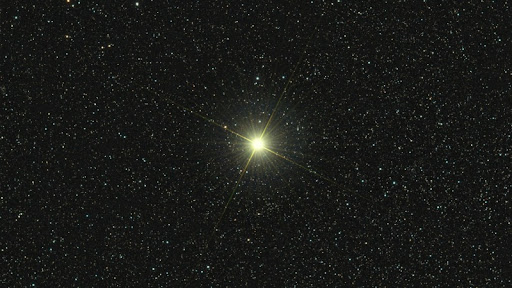
- Color: Yellow (G-type)
- Spectral type: G3III
- Apparent magnitude: 0.08
- Mass: ≈ 2.5 solar masses
- Constellation: Auriga
- Distance: ≈ 42.9 light-years from Earth
Capella or Alpha Aurigae is the brightest star in the Auriga constellation. It is a G-type star like the Sun, so it also has a yellow glow. This star system has a combined apparent magnitude of 0.08 which makes it easily visible to the naked eye.
The Capella Star is located in the northern celestial hemisphere. In fact, it is the third brightest star in the northern sky after Arcturus in Boötes constellation and Vega in Lyra. Also, aside from the Sun, it is the largest and brightest yellow star that we can see in the sky.
Many Stars
Though Capella looks like a single yellow point, it is actually a quadruple star system made up of two binary stars. The main pair is Capella A which is composed of Capella Aa and Capella Ab. Both of which are giant stars with a yellow hue. The smaller pair is called Capella HL and is composed of the red dwarf stars Capella H and Capella L.
The easiest time of the year to see Capella is during winter. Apart from this star being exceptionally bright, it is also part of the Winter Hexagon asterism. More than 200,000 years ago, Capella was the brightest star in the sky. At present, this place is now taken by Sirius, also known as the “Dog Star.”
As the most notable star in the constellation of Auriga, certain mythological stories have also been related to Capella. It was most famously associated with Amalthea in Greek mythology. She was the she-goat that suckled the infant Zeus.
The Capella system lies around 42.9 light-years from the solar system. The smaller Capella HL pair is located roughly 10,000 astronomical units (AU) from the main pair of G-type stars. That is 10,000 times the distance between the Sun and Earth!
What’s In a Name?
The name “Capella” is from Latin which means “small female goat.” This traditional name represents the goat that Auriga the Charioteer is holding on his left shoulder. On top of this, the goat is most commonly depicted with two kids. These younger goats are marked by the stars Zeta Aurigae (Sadatoni ) and Eta Aurigae (Haedus).
The name of this star has similar references across cultures. For the Arabic, it was referred to as “the goat” or “goat star,” and was called al-‘Ayyuq. Its Sumerian name mul.ÁŠ.KAR also has the same meaning. This star points to the famous Pleiades so the Bedouin called it “Capella of the Pleiades.”
The Assyrian name of this star is I-ku which translates to “the leader.” This signifies the role of the star which signaled the start of the year. It was determined through the position of Capella relative to the Moon and the vernal equinox.
Aside from the α Aurigae Bayer designation, other designations of this star include HIP 24608, HR 1708, and HD 34029.
The Capella Star System
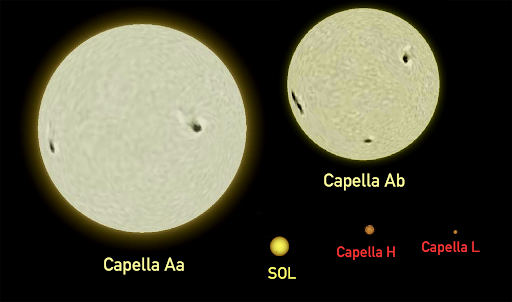
Capella is a four-star system made up of two binary pairs. Aside from that, Capella also has visual companion stars. These are physically non-related stars that appear close to Capella from our vantage point on Earth.
Capella Aa and Capella Ab
| Spectral class | Radius | Mass | Luminosity | |
|---|---|---|---|---|
| Capella Aa | G8III/K0III | 12.2 solar radii | 2.69 solar masses | 78.5 Suns |
| Capella Ab | G1 III | 9.2 solar radii | 2.56 solar masses | 77.6 Suns |
Capella A is a spectroscopic binary made up of Capella Aa and Capella Ab. Unlike visual binaries where we can see a double star, spectroscopic binaries appear as a single star. This is because the stars are located close to each other.
At 0.74 AU away, Capella Aa and Ab are closer to each other than the Earth is to the Sun. They have an orbital period of 104 days. These are yellow stars that are about 3 times as massive as the Sun.
The two stars of the Capella A system are both larger than the Sun. Capella Aa is 12.2 times larger while Capella Aa has about 9 times the solar radius. These stars are about 80 times as bright as the Sun. They have roughly similar surface temperatures as the Sun. These stars are in transition to becoming red giants and are moving away from the main sequence.
Though, overall, Capella looks bright from Earth, splitting the two stars of this spectroscopic binary would be a challenge. Our binoculars and backyard telescopes will see it as a single star with a yellow glow.
Capella H and Capella L
| Spectral class | Radius | Mass | Luminosity | |
|---|---|---|---|---|
| Capella H | M1 | 0.54 solar radii | 0.53 solar masses | 0.05 Suns |
| Capella L | M5 | 0.19 solar masses |
Capella H is red dwarf star that is about half as massive as the Sun. It has a smaller and fainter companion, called Capella L. The binary stars Capella H and L are about 10,000 AU from the main pair, Capella A.
Auriga Constellation (The Charioteer)

The constellation of Auriga lies in the northern sky and has been long recognized in the past. The traditional name and the member stars of this constellation were adopted and included in the 88 modern constellations of today. It is the 21st largest constellation.
In 1930, the boundaries of Auriga were finalized, enclosing it in a 20-side polygon. Historically, some of its stars were once part of the now-obsolete constellation of Telescopium Herschelii. This constellation was made in honor of William Herschel for his discovery of the sideways planet, Uranus.
Auriga is a northern constellation and it is only fully visible up to 34°S latitude. The brightest star, Capella, is followed by Menkalinan (Beta Aurigae) which has a combined apparent magnitude of 1.9.
Other naked eye stars of lesser magnitude include Iota Aurigae, Delta Aurigae, Lambda Aurigae, and Epsilon Aurigae. The star Beta Tauri was once a part of Auriga with the designation Gamma Aurigae. Together, the stars Alpha, Beta, Gamma, Theta, and Gamma Aurigae are called the “Five Chariots” in Chinese astronomy.
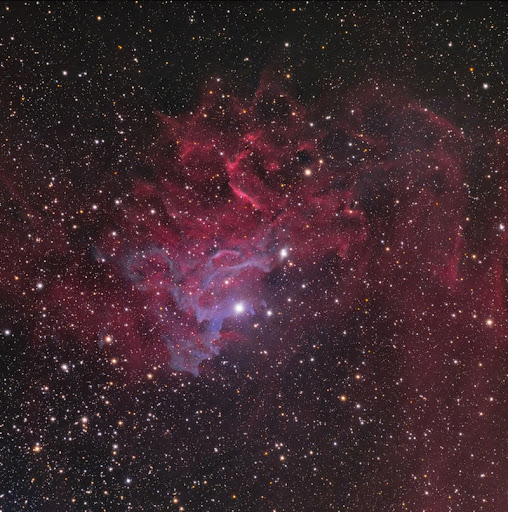
Apart from variable stars and binary systems, exoplanets have also been discovered orbiting some of Auriga’s stars. Since the arms of the Milky Way run through it, the constellation is a rich field of open clusters such as the Messier 36, Messier 37, and Messier 38.
The Flaming Star Nebula is found in Auriga. Another deep-sky object in Auriga is NGC 1931 which is often called the small version of the Orion Nebula. The Aurigid meteor shower originates from this constellation.
The Winter Hexagon
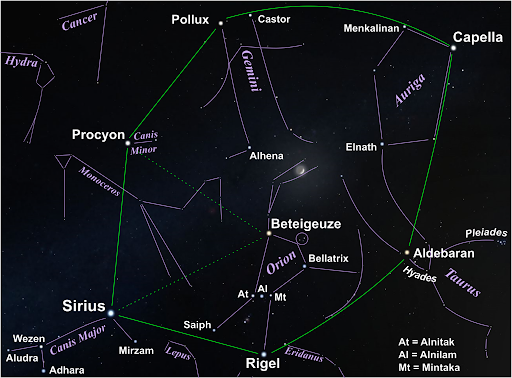
Aside from constellations, asterisms are other sky patterns that make our night sky more interesting. These patterns can be made up of stars from different constellations. One example of such is the Winter Hexagon.
The Winter Hexagon or the Winter Circle is most prominent in the northern celestial hemisphere from around December to March. During this time, it is summer in the southern hemisphere.
This asterism is made up of some of the brightest stars from six different constellations. These stars are:
- Rigel (Orion)
- Aldebaran (Taurus)
- Capella (Auriga)
- Pollux (Gemini)
- Procyon (Canis Minor)
- Sirius (Canis Major)
The smaller Winter Triangle is inside this asterism. Also called the Great Southern Triangle, it is composed of the stars Procyon, Sirius, and Betelgeuse.
The red supergiant Betelgeuse is not part of the Winter Hexagon. However, we can use it to find the winter asterisms. Orion is one of the easiest constellations to identify and Betelgeuse represents the shoulder of the celestial hunter. Once we find it, we can trace the Winter Triangle and, ultimately, locate the bigger Winter Hexagon.
Where Can You See Capella in the Night Sky?
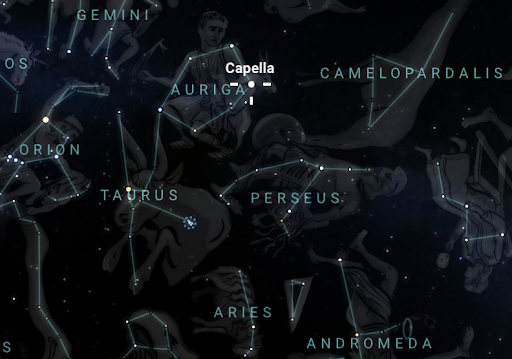
The constellation of Auriga the Charioteer is located predominantly north. That said, the main star Capella is also mostly seen in the northern sky. Below are its coordinates:
- Right Ascension: 5h 16m 41.4s
- Declination: +45° 59′ 53″
Capella is circumpolar in areas above 44°N. This means it is visible every night, all year long, in the United Kingdom, Canada, and the northern part of the adjoining United States. Because of its northern declination, it does not rise above the horizon in areas south of 44°S. Argentina and Chile are two examples of countries where this star is not visible.
How and When To Find Capella?
The best time to spot Capella is during winter in the northern hemisphere. It climbs the highest in the sky in December but is still prominent up to March.
The easiest way to find this star is through its constellation. Auriga is surrounded by the following neighboring constellations:
- Camelopardalis (the Giraffe)
- Perseus (the Hero)
- Taurus (the Bull)
- Gemini (the Twins)
- Lynx (the Lynx)
You know that you have found Capella when there is a small triangle asterism located southwest. This pattern is made up of the stars Epsilon, Zeta, and Eta Aurigae. Zeta and Eta Aurigae are called Haedi or “The Kids,” the two young goats held by the Charioteer.
Also, an imaginary straight line from Vega in the Lyra constellation will point to Capella, which is on the other side of Polaris. We can also use the Big Dipper to locate Capella. While the stars Dubhe and Merak point to Polaris, extending a straight line from Dubhe and Megrez will reveal the golden glow of Capella.
Capella Star in History & Mythology
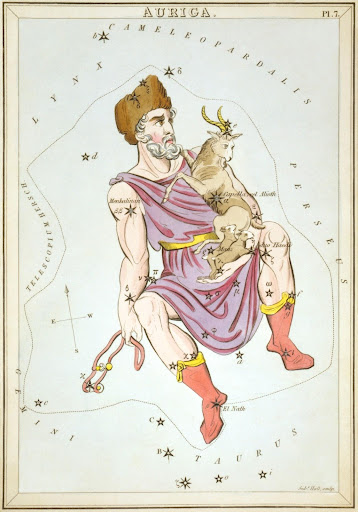
As constellations changed over the years, the depiction of Capella in Auriga has also undergone changes. The constellation of Auriga is known as the charioteer who is carrying a goat on his left arm. Together with that goat are its two kids. Meanwhile, the charioteer’s right arm is holding his chariot’s reins.
Traditionally, the star Capella marks Aurigas’s left shoulder. However, the most famous depiction of the star is that it is the goat that the charioteer is carrying.
The two small goats with Capella are called the Haedi which means “the Kids.” They are represented by the stars Zeta Aurigae and Eta Aurigae. These two stars also form an asterism with the F-type star Epsilon Aurigae.
Interestingly, Capella and the Kids were a separate constellation before. It was only in the second century when Ptolemy compiled the Almagest that these three goats were combined with the Charioteer. Before that, other star names related to Capella were Capra, Caper, and Hircus.
Other Depictions
The constellation of Auriga has several other depictions as well. In other atlases, the Charioteer was shown driving a cart pulled by oxen and horses. Other versions even included a zebra. In a Turkish atlas, the stars were represented by a mule instead of goats.
In mythology, Capella is associated with Amalthea who nursed Zeus when he was young. Zeus’ father, Cronus, swallowed all his children upon birth. After giving birth to Zeus, his mother Rhea gave a stone to Cronus instead of the baby.
Rhea then bought the infant Zeus to a cave where he was nursed and raised by Amalthea. It was said that Amalthea was a she-goat who suckled Zeus. Other accounts say that Amalthea had a goat from which she gets the milk to feed Zeus.
When Amalthea died, Zeus took her skin or that of her goat, and it became the famous aegis.
Auriga Mythology

Myths and stories are tied with the Auriga constellation. In mythology, it is associated with the stories of Erichthonius, Myrtilus, and Bellerophon. It is also associated with Hippolytus, who refused the advances of his stepmother, Phaedra.
Erichthonius was the son of Hephaestus who invented the quadriga. The quadriga is a four-horse chariot. Erichthonius used this in his battle against Amphictyon. He came out victorious in this battle and later became the king of Athens.
He often drove and used his chariot for racing and games. Zeus was impressed with the king’s skill so he placed Erichthonius in the sky as Auriga the Charioteer.
In another story, the constellation of Auriga was said to be Myrtilus. He was the son of the messenger of the gods Hermes. Myrtilus was a charioteer king.
A chariot race was organized to decide who will take the hand of Hippodamia, daughter of King Oenomaus. One of the suitors, Pelops, approached Myrtilus to sabotage Oenomaus’s chariot. Pelops also promised that if he wins the race, he will let Myrtilus spend a night with Hippodamia.
Myrtilus himself was enthralled by the princess so he did as Pelops instructed. When the race started, the king got into an accident and died. Thinking it was time for him to get his bribe, Myrtilus made advances to Hippodamia who, in turn, ran to Pelops for help.
As if he did not initiate the way things happened, Pelops became so angry that he took Myrtilus ‘s life. He also became the king of Pisa and married Hippodamia.
After the death of Myrtilus, his father Hermes raised him in the sky as the constellation of Auriga. No chariot is depicted in the constellation as it is said that Myrtilus’s chariot was wrecked during the race.
Other Tales
In a lesser-known tale, Auriga is not seen as the Charioteer. Instead, it was said to be Bellerophon.

Bellerophon was a Greek hero who rode the untamed horse Pegasus on his quest to kill the Chimera. He was victorious in taming Pegasus and was also successful in killing the Chimera.
King Iobates gave many other missions to Bellerophon which the latter had always been successful. Because of his many conquests, Bellerophon became arrogant that he dared to fly Pegasus to Mount Olympus. Zeus was not happy about this so he sent a gadfly to sting Pegasus and Bellerophon ended up falling off to Earth.
In this story, it was said that Zeus (or Jupiter) pitied Bellerophon’s boldness and foolishness so he placed him in the heavens among the stars.
Sources:
(https://earthsky.org/brightest-stars/capella-is-the-stellar-beacon-of-auriga-the-charioteer/)
(https://skyandtelescope.org/astronomy-news/meet-capella-goat-star/)
Image Sources:
Capella: https://earthsky.org/upl/2016/01/capella.jpg
Capella System: https://upload.wikimedia.org/wikipedia/commons/thumb/0/03/Capella-Sun_comparison.png/1280px-Capella-Sun_comparison.png
Auriga constellation: https://upload.wikimedia.org/wikipedia/commons/thumb/9/92/Auriga_IAU.svg/800px-Auriga_IAU.svg.png
Flaming star nebula: https://upload.wikimedia.org/wikipedia/commons/thumb/d/dd/FlamingStarHunterWilson.jpg/800px-FlamingStarHunterWilson.jpg
Winter hexagon: https://upload.wikimedia.org/wikipedia/commons/thumb/a/ad/Winter_Hexagon_and_Great_Southern_Triangle_%28Stellarium%29.png/1024px-Winter_Hexagon_and_Great_Southern_Triangle_%28Stellarium%29.png
Where to see Capella: https://stellarium-web.org/
Capella in History & Mythology: https://upload.wikimedia.org/wikipedia/commons/7/7f/Sidney_Hall_-_Urania%27s_Mirror_-_Auriga.jpg
Quadriga: https://upload.wikimedia.org/wikipedia/commons/thumb/b/bb/Horses_of_Basilica_San_Marco_bright.jpg/1024px-Horses_of_Basilica_San_Marco_bright.jpg
Bellerophon and Pegasus: https://upload.wikimedia.org/wikipedia/commons/thumb/0/00/The-Winged-Horse.jpg/800px-The-Winged-Horse.jpg